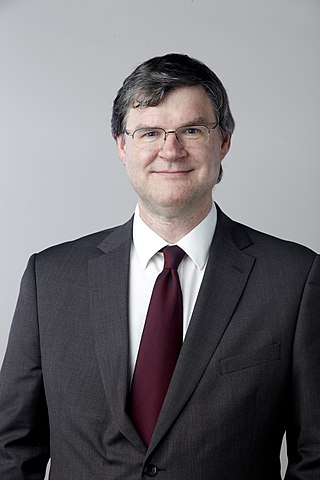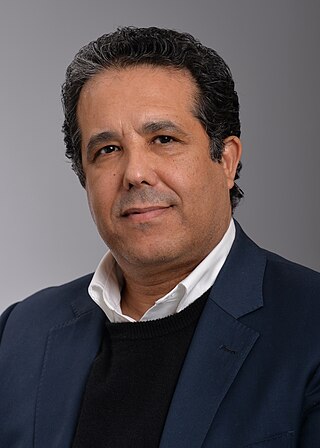Related Research Articles

The Compact Muon Solenoid (CMS) experiment is one of two large general-purpose particle physics detectors built on the Large Hadron Collider (LHC) at CERN in Switzerland and France. The goal of the CMS experiment is to investigate a wide range of physics, including the search for the Higgs boson, extra dimensions, and particles that could make up dark matter.

ATLAS is the largest general-purpose particle detector experiment at the Large Hadron Collider (LHC), a particle accelerator at CERN in Switzerland. The experiment is designed to take advantage of the unprecedented energy available at the LHC and observe phenomena that involve highly massive particles which were not observable using earlier lower-energy accelerators. ATLAS was one of the two LHC experiments involved in the discovery of the Higgs boson in July 2012. It was also designed to search for evidence of theories of particle physics beyond the Standard Model.

The LHCb experiment is a particle physics detector experiment collecting data at the Large Hadron Collider at CERN. LHCb is a specialized b-physics experiment, designed primarily to measure the parameters of CP violation in the interactions of b-hadrons. Such studies can help to explain the matter-antimatter asymmetry of the Universe. The detector is also able to perform measurements of production cross sections, exotic hadron spectroscopy, charm physics and electroweak physics in the forward region. The LHCb collaborators, who built, operate and analyse data from the experiment, are composed of approximately 1650 people from 98 scientific institutes, representing 22 countries. Vincenzo Vagnoni succeeded on July 1, 2023 as spokesperson for the collaboration from Chris Parkes. The experiment is located at point 8 on the LHC tunnel close to Ferney-Voltaire, France just over the border from Geneva. The (small) MoEDAL experiment shares the same cavern.

The Collider Detector at Fermilab (CDF) experimental collaboration studies high energy particle collisions from the Tevatron, the world's former highest-energy particle accelerator. The goal is to discover the identity and properties of the particles that make up the universe and to understand the forces and interactions between those particles.

The DØ experiment was a worldwide collaboration of scientists conducting research on the fundamental nature of matter. DØ was one of two major experiments located at the Tevatron Collider at Fermilab in Batavia, Illinois. The Tevatron was the world's highest-energy accelerator from 1983 until 2009, when its energy was surpassed by the Large Hadron Collider. The DØ experiment stopped taking data in 2011, when the Tevatron shut down, but data analysis is still ongoing. The DØ detector is preserved in Fermilab's DØ Assembly Building as part of a historical exhibit for public tours.
Joseph Incandela is an American particle physicist, a professor of physics at the University of California, Santa Barbara and currently based at CERN, where he spent two years as the spokesperson for the Compact Muon Solenoid experiment at the Large Hadron Collider.

David George Charlton is Professor of Particle Physics in the School of Physics and Astronomy at the University of Birmingham, UK. From 2013 to 2017, he served as Spokesperson of the ATLAS experiment at the Large Hadron Collider at CERN. Prior to becoming Spokesperson, he was Deputy Spokesperson for four years, and before that Physics Coordinator of ATLAS in the run-up to the start of collision data-taking.

Sir Tejinder Singh Virdee,, is a Kenyan-born British experimental particle physicist and Professor of Physics at Imperial College London. He is best known for originating the concept of the Compact Muon Solenoid (CMS) with a few other colleagues and has been referred to as one of the 'founding fathers' of the project. CMS is a world-wide collaboration which started in 1991 and now has over 3500 participants from 50 countries.

Jonathan Mark Butterworth is a Professor of Physics at University College London (UCL) working on the ATLAS experiment at CERN's Large Hadron Collider (LHC). His popular science book Smashing Physics, which tells the story of the search for the Higgs boson, was published in 2014 and his newspaper column / blog Life and Physics is published by The Guardian.

Daniela Bortoletto is an Italian-British high energy physicist, head of Particle Physics at the University of Oxford and Nicholas Kurti Senior Research Fellow in Physics at Brasenose College, University of Oxford. She works in silicon detector development and was a co-discoverer of both the Higgs boson and the top quark.
Paraskevas Andreas Sphicas is a particle physicist who focuses on studies of High energy collisions in the Large Hadron Collider through which he explores supersymmetry and the mechanism of spontaneous symmetry breaking. He is a senior scientist at CERN and professor of physics at the National and Kapodistrian University of Athens. He was elected a Fellow of the Royal Society (FRS) in 2019.
George H. Trilling was a Polish-born American particle physicist. He was co-discoverer of the J/ψ meson which evinced the existence of the charm quark. Trilling joined the Physics Department faculty at the University of California, Berkeley, in 1960, where he was Department Chair from 1968 through 1972. Trilling was on sabbatical leave to CERN in 1973–74, where he worked on the study of the properties of charm particles, their decay modes and excited states. He was also director of the Physics Division at the Lawrence Berkeley National Laboratory from 1984 until 1987. Trilling was a principal proponent of the Superconducting Super Collider project and spokesperson for the Solenoidal Detector Collaboration. After the SSC was cancelled in 1993, Trilling transitioned most of the SDC team to collaborate on the ATLAS experiment at the LHC, which led to the discovery of the Higgs boson in 2012. Trilling was elected vice-president of the American Physical Society, beginning his term on 1 January 1999, and was president of the society in 2001.
Tulika Bose is a professor of physics at the University of Wisconsin-Madison, whose research focuses on developing triggers for experimental searches of new phenomena in high energy physics. Bose is a leader within the Compact Muon Solenoid (CMS) experiment, a CERN collaboration famous for its experimental observation of the Higgs boson in 2012.
Sinéad Farrington is a British particle physicist who works on the ATLAS experiment at the Large Hadron Collider.

Bradley Cox is an American physicist, academic and researcher. He is a Professor of Physics and the founder of the High Energy Physics Group at the University of Virginia.

Kamal Benslama is a Moroccan-Swiss experimental particle physicist. He is a professor of physics at Drew University, a visiting experimental scientist at Fermilab, and a guest scientist at Brookhaven National Laboratory. He worked on the ATLAS experiment, at the Large Hadron Collider (LHC) at CERN in Switzerland. Currently, he is a member of the Mu2e experiment at Fermilab.
Oliver Buchmueller is a scientist and professor of physics at the Faculty of Natural Science, Imperial College London. Buchmueller is presently serving as one of the lead scientists on the Compact Muon Solenoid experiment at CERN’s Large Hadron Collider, the principal investigator of the Atom Interferometer Observatory and Network and also one of the lead authors at Atomic Experiment for Dark Matter and Gravity Exploration in Space (AEDGE). Previously he has been associated with the ALEPH experiment at CERN’s LEP collider and the BaBar experiment at SLAC. Buchmueller was among the group of scientists responsible for the discovery of Higgs Boson particle at the LHC, CERN and later in the scientific exploration to find the traces of dark matter through the LHC.

Sheldon Leslie Stone was a distinguished professor of physics at Syracuse University. He is best known for his work in experimental elementary particle physics, the Large Hadron Collider beauty experiment (LHCb), and B decays. He made significant contributions in the areas of data analysis, LHCb detector design and construction, and phenomenology.
Geoffrey Hall, is a British particle physicist, currently Professor of Physics at Imperial College London. He is best known for developing radiation and particle detectors and other electronic instruments for use in particle physics experiments, notably the CMS detector in CERN's Large Hadron Collider.
Freya Blekman is a Dutch professor at the University of Hamburg and the lead scientist at Deutsches Elektronen-Synchrotron (DESY). She contributed to the discovery of the Higgs boson at CERN and has been endowed the Helmholtz Distinguished Professorship. Her individual work specializes in the physics and experimental aspects of elementary particles and fields, specifically looking at the top quark sector by using precision measurements.
References
- 1 2 3 4 Indaco, Elizabeth (8 October 2024). "Professor Ian Shipsey FRS | University of Oxford Department of Physics". www.physics.ox.ac.uk. Retrieved 12 October 2024.
- ↑ Shipsey, Ian (1986). Measurement of the two gamma decays of neutral K-mesons (Ph.D. thesis). University of Edinburgh.
- ↑ "Professor Ian Shipsey (1959–2024)". St. Catherine's College, University of Oxford. 8 October 2024.
- ↑ "Fellow Detail Page | Royal Society". royalsociety.org. Retrieved 12 October 2024.
- ↑ "Ian P.J. Shipsey". www.inspirehep.net. Retrieved 16 October 2024.
- ↑ "Tribute to Professor Ian Shipsey". Edinburgh University. 2024.
- ↑ "Professor Ian Shipsey elected Fellow of the Royal Society". www.physics.ox.ac.uk. 10 May 2022. Retrieved 15 October 2024.
- ↑ Foster, Brian (7 November 2024). "Ian Shipsey obituary". The Guardian. Retrieved 7 November 2024.